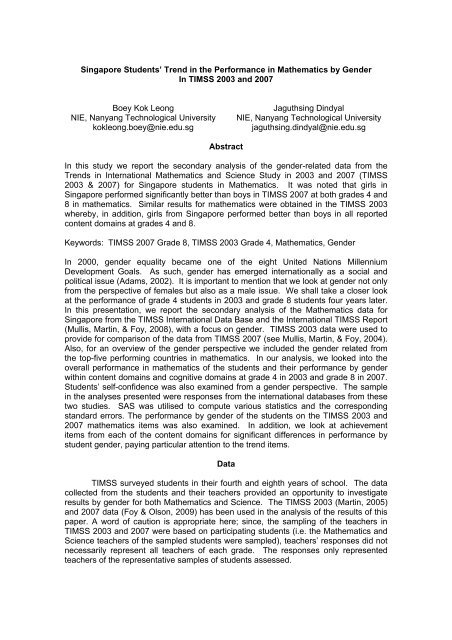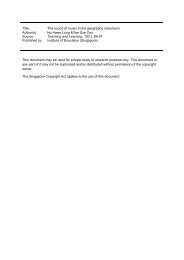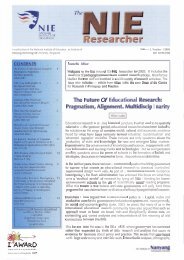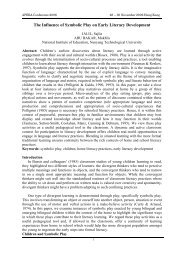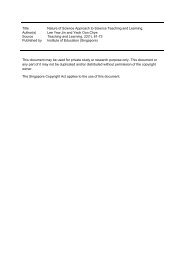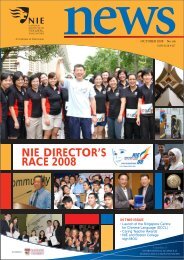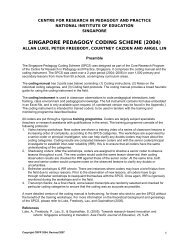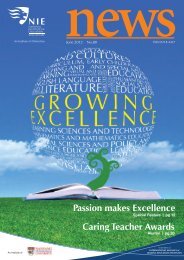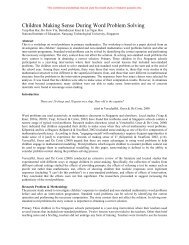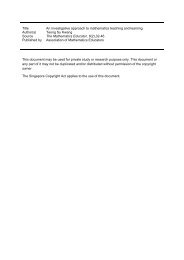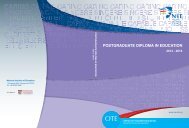Boey Kok Leong an - NIE Digital Repository
Boey Kok Leong an - NIE Digital Repository
Boey Kok Leong an - NIE Digital Repository
You also want an ePaper? Increase the reach of your titles
YUMPU automatically turns print PDFs into web optimized ePapers that Google loves.
Singapore Students’ Trend in the Perform<strong>an</strong>ce in Mathematics by GenderIn TIMSS 2003 <strong>an</strong>d 2007<strong>Boey</strong> <strong>Kok</strong> <strong>Leong</strong><strong>NIE</strong>, N<strong>an</strong>y<strong>an</strong>g Technological Universitykokleong.boey@nie.edu.sgJaguthsing Dindyal<strong>NIE</strong>, N<strong>an</strong>y<strong>an</strong>g Technological Universityjaguthsing.dindyal@nie.edu.sgAbstractIn this study we report the secondary <strong>an</strong>alysis of the gender-related data from theTrends in International Mathematics <strong>an</strong>d Science Study in 2003 <strong>an</strong>d 2007 (TIMSS2003 & 2007) for Singapore students in Mathematics. It was noted that girls inSingapore performed signific<strong>an</strong>tly better th<strong>an</strong> boys in TIMSS 2007 at both grades 4 <strong>an</strong>d8 in mathematics. Similar results for mathematics were obtained in the TIMSS 2003whereby, in addition, girls from Singapore performed better th<strong>an</strong> boys in all reportedcontent domains at grades 4 <strong>an</strong>d 8.Keywords: TIMSS 2007 Grade 8, TIMSS 2003 Grade 4, Mathematics, GenderIn 2000, gender equality became one of the eight United Nations MillenniumDevelopment Goals. As such, gender has emerged internationally as a social <strong>an</strong>dpolitical issue (Adams, 2002). It is import<strong>an</strong>t to mention that we look at gender not onlyfrom the perspective of females but also as a male issue. We shall take a closer lookat the perform<strong>an</strong>ce of grade 4 students in 2003 <strong>an</strong>d grade 8 students four years later.In this presentation, we report the secondary <strong>an</strong>alysis of the Mathematics data forSingapore from the TIMSS International Data Base <strong>an</strong>d the International TIMSS Report(Mullis, Martin, & Foy, 2008), with a focus on gender. TIMSS 2003 data were used toprovide for comparison of the data from TIMSS 2007 (see Mullis, Martin, & Foy, 2004).Also, for <strong>an</strong> overview of the gender perspective we included the gender related fromthe top-five performing countries in mathematics. In our <strong>an</strong>alysis, we looked into theoverall perform<strong>an</strong>ce in mathematics of the students <strong>an</strong>d their perform<strong>an</strong>ce by genderwithin content domains <strong>an</strong>d cognitive domains at grade 4 in 2003 <strong>an</strong>d grade 8 in 2007.Students’ self-confidence was also examined from a gender perspective. The samplein the <strong>an</strong>alyses presented were responses from the international databases from thesetwo studies. SAS was utilised to compute various statistics <strong>an</strong>d the correspondingst<strong>an</strong>dard errors. The perform<strong>an</strong>ce by gender of the students on the TIMSS 2003 <strong>an</strong>d2007 mathematics items was also examined. In addition, we look at achievementitems from each of the content domains for signific<strong>an</strong>t differences in perform<strong>an</strong>ce bystudent gender, paying particular attention to the trend items.DataTIMSS surveyed students in their fourth <strong>an</strong>d eighth years of school. The datacollected from the students <strong>an</strong>d their teachers provided <strong>an</strong> opportunity to investigateresults by gender for both Mathematics <strong>an</strong>d Science. The TIMSS 2003 (Martin, 2005)<strong>an</strong>d 2007 data (Foy & Olson, 2009) has been used in the <strong>an</strong>alysis of the results of thispaper. A word of caution is appropriate here; since, the sampling of the teachers inTIMSS 2003 <strong>an</strong>d 2007 were based on participating students (i.e. the Mathematics <strong>an</strong>dScience teachers of the sampled students were sampled), teachers’ responses did notnecessarily represent all teachers of each grade. The responses only representedteachers of the representative samples of students assessed.


